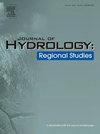机器学习建模揭示青藏高原内流湖湖水盐度的空间变化
IF 4.7
2区 地球科学
Q1 WATER RESOURCES
引用次数: 0
摘要
研究区域青藏高原(TP)。研究重点湖水盐度是反映湖泊水文和物理化学特征变化的敏感指标。由于受到地理和气候因素的不同影响,湖水盐度对环境的多样性和变化高度敏感。大洋洲的湖泊分布广泛,其中大部分属于内流式排水类型,属于盐湖或咸水湖。通过广泛的实地调查和荟萃分析,本研究基于 100 个终端湖泊(1 平方公里)的测量数据和相关物理变量建立了机器学习模型。最佳模型(R2 = 0.90、MAE = 8.11 g/L、MAPE = 36.40 %、RMSE = 12.51 g/L、RRMSE = 36.96 g/L)随后被用于预测其他 214 个未测量终端湖泊的水盐度。建模结果显示,这些终端湖泊的水体盐度在整个内流河流域呈现出由南向北递增的空间变化规律。水盐度的进一步分类表明,半数以上(213 个)的终端湖泊处于低盐状态。这项研究有助于从空间上明确了解终极热量湖泊水盐度的分布变化,并为在大尺度上估算未测量湖泊的水盐度提供了一种可行的方法。本文章由计算机程序翻译,如有差异,请以英文原文为准。
Machine learning modeling reveals the spatial variations of lake water salinity on the endorheic Tibetan Plateau
Study region
The endorheic Tibetan Plateau (TP).
Study focus
Water salinity is sensitive indicator for variations of lake hydrologic and physicochemical characteristics. Due to the heterogeneous influences from geographical and climatic factors, lake water salinity is highly sensitive to environmental diversity and changes. The TP hosts a wide distribution of lakes, the majority of which belong to endorheic drainage type and are saline or salty lakes. However, the harsh environment on the TP poses great challenges for the in–site measurements at large scales, impeding the comprehension of the pattern and variations of lake water salinity across the TP.
New hydrological insights for the region
Benefiting extensive field surveys and a meta–analysis, this study establishes machine learning models based on measurements from 100 terminal lakes (>1 km2) and related physical variables. The optimal model (R2 = 0.90, MAE = 8.11 g/L, MAPE = 36.40 %, RMSE = 12.51 g/L, RRMSE = 36.96 g/L) is then applied to predict the water salinity of the other 214 unmeasured terminal lakes. The modeling results reveal a spatial variation pattern of increasing water salinity of these terminal lakes from south to north across the endorheic basins. Further classification of water salinity levels indicated that more than half (213) of the terminal lakes are in an oligosaline state. This study contributes to a spatially–explicit understanding of the distribution variations in water salinity of terminal TP lakes and provides a feasible approach for estimating water salinity of unmeasured lakes at large scales.
求助全文
通过发布文献求助,成功后即可免费获取论文全文。
去求助
来源期刊

Journal of Hydrology-Regional Studies
Earth and Planetary Sciences-Earth and Planetary Sciences (miscellaneous)
CiteScore
6.70
自引率
8.50%
发文量
284
审稿时长
60 days
期刊介绍:
Journal of Hydrology: Regional Studies publishes original research papers enhancing the science of hydrology and aiming at region-specific problems, past and future conditions, analysis, review and solutions. The journal particularly welcomes research papers that deliver new insights into region-specific hydrological processes and responses to changing conditions, as well as contributions that incorporate interdisciplinarity and translational science.
 求助内容:
求助内容: 应助结果提醒方式:
应助结果提醒方式:


